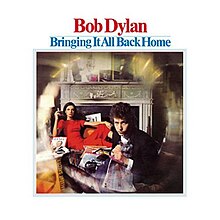Bringing It All Back Home
| Bringing It All Back Home | ||||
|---|---|---|---|---|
 |
||||
| Studio album by Bob Dylan | ||||
| Released | March 22, 1965 | |||
| Recorded | January 13–15, 1965 | |||
| Studio | Columbia Recording Studios, New York City | |||
| Genre | ||||
| Length | 47:14 | |||
| Label | Columbia | |||
| Producer | Tom Wilson | |||
| Bob Dylan chronology | ||||
|
||||
| Singles from Bringing It All Back Home | ||||
|
||||
| Professional ratings | |
|---|---|
| Review scores | |
| Source | Rating |
| AllMusic | |
| Chicago Tribune | |
| Encyclopedia of Popular Music | |
| Entertainment Weekly | A |
| Music Story | |
| MusicHound Rock | 4.5/5 |
| The Rolling Stone Album Guide | |
Bringing It All Back Home is the fifth studio album by American singer-songwriter Bob Dylan, released on March 22, 1965 by Columbia Records. The album is divided into an electric and an acoustic side, although the acoustic side included some tracks in which other instruments were backing up Dylan and his guitar, but no drums were used. On side one of the original LP, Dylan is backed by an electric rock and roll band—a move that further alienated him from some of his former peers in the folk music community. Likewise, on the acoustic second side of the album, he distanced himself from the protest songs with which he had become closely identified (such as "Blowin' in the Wind" and "A Hard Rain's a-Gonna Fall"), as his lyrics continued their trend towards the abstract and personal.
The album reached No. 6 on Billboard's Pop Albums chart, the first of Dylan's LPs to break into the US top 10. It also topped the UK charts later that Spring. The first track, "Subterranean Homesick Blues", became Dylan's first single to chart in the US, peaking at #39.
Dylan spent much of the summer of 1964 in , a small town in upstate New York. Dylan was already familiar with the area, but his visits were becoming longer and more frequent. His manager, Albert Grossman, also had a place in Woodstock, and when Joan Baez went to see Dylan that August, they stayed at Grossman's house.
Baez recalls that "most of the month or so we were there, Bob stood at the typewriter in the corner of his room, drinking red wine and smoking and tapping away relentlessly for hours. And in the dead of night, he would wake up, grunt, grab a cigarette, and stumble over to the typewriter again." Dylan already had one song ready for his next album: "Mr. Tambourine Man" was written in February 1964 but omitted from Another Side of Bob Dylan. Another song, "Gates of Eden", was also written earlier that year, appearing in the original manuscripts to Another Side of Bob Dylan; a few lyrical changes were eventually made, but it's unclear if these were made that August in Woodstock. At least two songs were written that month: "If You Gotta Go, Go Now" and "It's Alright Ma (I'm Only Bleeding)".
...
Wikipedia
